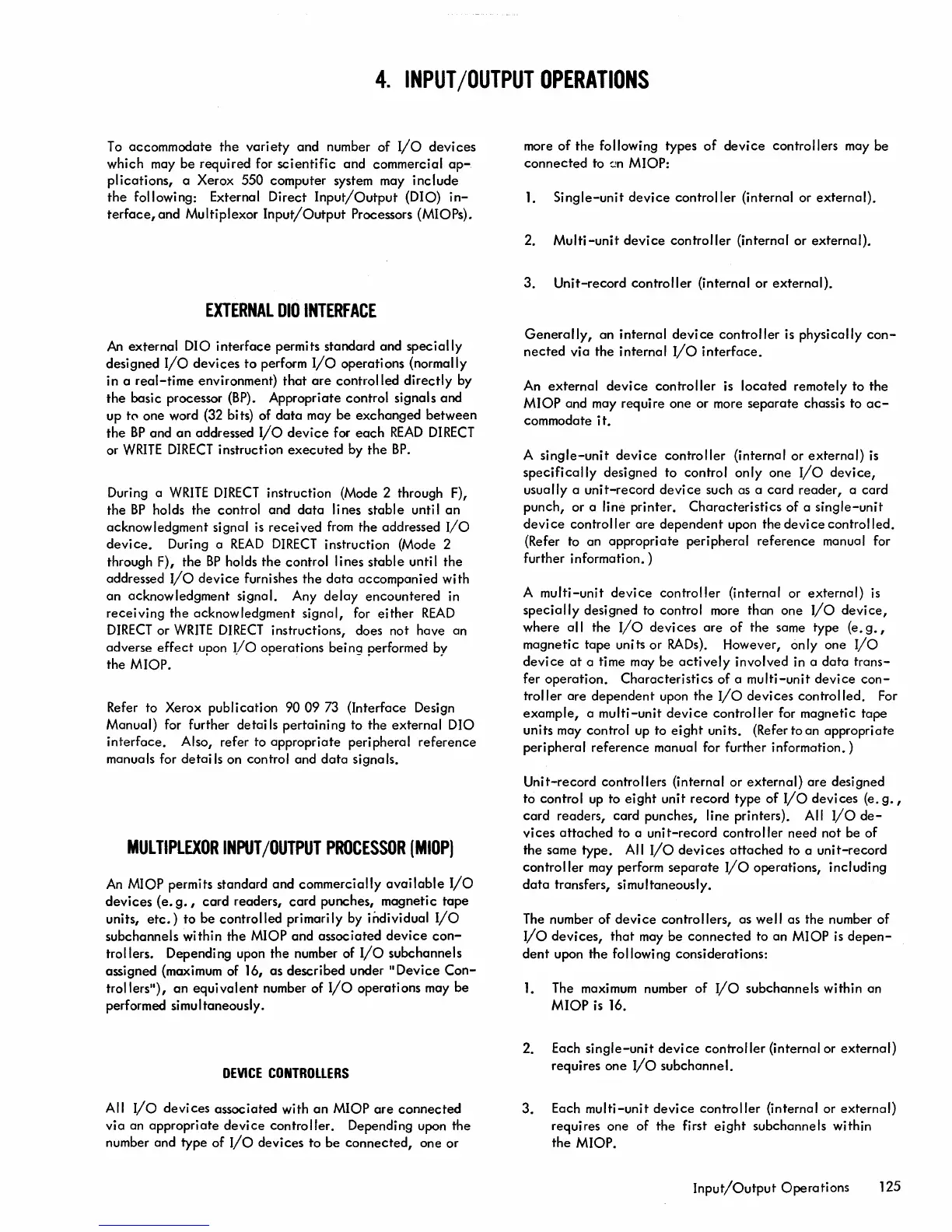4.
INPUT/OUTPUT
OPERATIONS
To
accommodate
the
variety
and number
of
I/o
devices
which may be required for
scientific
and commercial
ap-
plications,
a Xerox 550 computer system may
include
the
following: External Direct
Input/Output
(DIO)
in-
terface,
and Multiplexor
Input/Output
Processors (MIOPs).
EXTERNAL
010
INTERFACE
An
external DIO
interface
permits standard and
specially
designed
I/O
devices
to
perform
I/o
operations (normally
in a
real-time
environment)
that
are
controlled
directly
by
the
basic processor
(BP).
Appropriate control signals and
up
tC'
one word (32 bits) of
data
may
be
exchanged
between
the
BP
and
an
addressed
I/O
device
for
each
READ
DIRECT
or
WRITE
DIRECT
instruction
executed
by
the
BP.
During a
WRITE
DIRECT
instruction (Mode 2 through F),
the
BP
holds the control and
data
lines
stable
until
an
acknowledgment signal
is
received
from
the addressed
I/O
device.
During a
READ
DIRECT
instruction (Mode 2
through F), the
BP
holds
the
control lines stabl e unti I the
addressed
I/O
device
furnishes the
data
accompanied with
an acknowledgment signal. Any
delay
encountered in
receiving
the acknowledgment signal, for
either
READ
DIRECT
or
WRITE
DIRECT
instructions, does not have an
adverse
effect
upon
I/O
operations being performed by
the
MIOP.
Refer to Xerox publication 90
09
73
(Interface Design
Manual) for further detai
Is
pertaining to the external DIO
interface.
Also, refer to appropriate peripheral reference
manuals for
detai
Is
on control and
data
signals.
MULTIPLEXOR
INPUT/OUTPUT
PROCESSOR
(MIOP)
An
MIOP permits standard and commercially
available
I/O
devices
(e.
g.,
card
readers,
card
punches, magnetic
tape
units,
etc.)
to
be controlled primarily by individual
I/O
subchannels within the MIOP and associated
device
con-
trollers. Depending upon the number of
I/O
subchannels
assigned (maximum of 16, as described under
II
Device
Con-
trollers"),
an
equivalent
number of
I/O
operations may
be
performed simultaneously.
DEVICE
CONTROLLERS
All
I/O
devices associated with
an
MIOP
are
connected
via an appropriate
device
controller. Depending upon the
number and type of
I/O
devices to be
connected,
one or
more
of
the following types
of
device
controllers may be
connected
to
(.!n
MIOP:
1.
Single-unit
device
controller
{internal or external}.
2.
Mu
I ti
-un
it
dev
ice
con tro
II
er
(i
n terna I or externa
I).
3.
Unit-record
controller (internal
or
external).
Generally,
an internal
device
controller
is physically
con-
nected
via the internal
I/O
interface.
An
external
device
controller
is
located
remotely to the
MIOP and may require one or more
separate
chassis to
ac-
commodate
it.
A
single-unit
device
controller
(internal or
external)
is
specifically
designed to control
only
one
I/O
device,
usually a
unit-record
device
such as a card reader, a card
punch, or a
line printer.
Characteristics
of
a
single-unit
device
controller
are
dependent
upon the
device
controlled.
(Refer to an appropriate peripheral reference manual for
further information. )
A
multi-unit
device
controller
(internal or
external)
is
specially
designed to control more than one
I/O
device,
where all the
I/O
devices
are
of
the same type
{e.
g.,
magnetic tape units or
RADs}.
However, only one
I/O
device
at
a time may be
actively
involved in a
data
trans-
fer
operation.
Characteristics of a
multi-unit
device
con-
troller are
dependent
upon the
I/O
devices controlled. For
example,
a multi
-unit
device
controller
for magnetic tape
units may control up to
eight
units. (Refer to an appropriate
peripheral reference manual for further information. )
Unit-record
controllers {internal or external}
are
designed
to control
up
to
eight
unit record type
of
I/O
devices
{e.
g.,
card
readers, card punches, line printers}. All
I/O
de-
vices
attached
to a
unit-record
controller need not be
of
the same type. All
I/O
devices
attached
to a
unit-record
controller
may perform
separate
I/O
operations, including
data
transfers, simultaneously.
The number
of
device
controllers, as well as the number
of
I/O
devices,
that
may be
connected
to
an
MIOP
is
depen-
dent
upon the following considerations:
1.
The maximum number
of
I/O
subchannels within an
MIOP
is
16.
2. Each
single-unit
device
controller
(internal or
external)
requires one
I/o
subchannel.
3.
Each multi
-unit
device
controller
(internal or
external)
requires one
of
the first
eight
subchannels within
the
MIOP.
Input/Output
Operations
125

